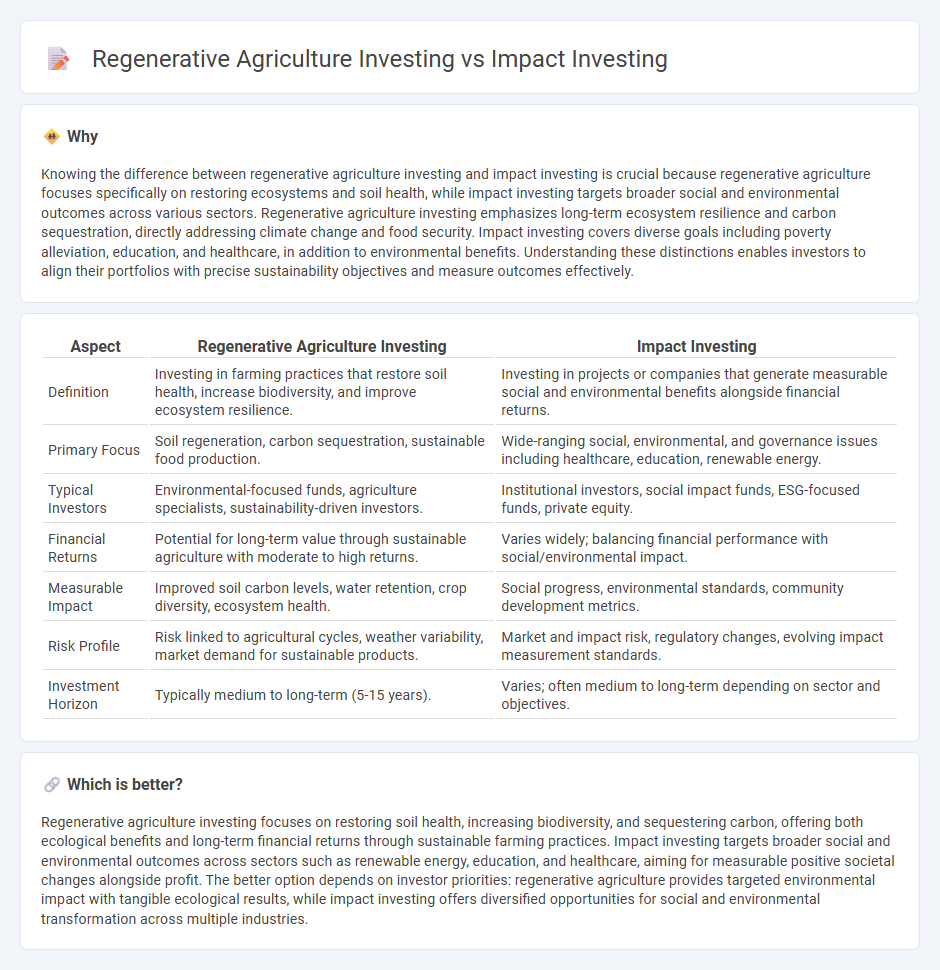
Regenerative agriculture investing focuses on restoring soil health, increasing biodiversity, and sequestering carbon while generating financial returns, making it a specialized subset of sustainable investment strategies. Impact investing encompasses a broader scope, targeting measurable social and environmental benefits across various sectors, including renewable energy, education, and healthcare. Explore the distinctions and benefits between these investment approaches to align your portfolio with your environmental and social goals.
Why it is important
Knowing the difference between regenerative agriculture investing and impact investing is crucial because regenerative agriculture focuses specifically on restoring ecosystems and soil health, while impact investing targets broader social and environmental outcomes across various sectors. Regenerative agriculture investing emphasizes long-term ecosystem resilience and carbon sequestration, directly addressing climate change and food security. Impact investing covers diverse goals including poverty alleviation, education, and healthcare, in addition to environmental benefits. Understanding these distinctions enables investors to align their portfolios with precise sustainability objectives and measure outcomes effectively.
Comparison Table
| Aspect | Regenerative Agriculture Investing | Impact Investing |
|---|---|---|
| Definition | Investing in farming practices that restore soil health, increase biodiversity, and improve ecosystem resilience. | Investing in projects or companies that generate measurable social and environmental benefits alongside financial returns. |
| Primary Focus | Soil regeneration, carbon sequestration, sustainable food production. | Wide-ranging social, environmental, and governance issues including healthcare, education, renewable energy. |
| Typical Investors | Environmental-focused funds, agriculture specialists, sustainability-driven investors. | Institutional investors, social impact funds, ESG-focused funds, private equity. |
| Financial Returns | Potential for long-term value through sustainable agriculture with moderate to high returns. | Varies widely; balancing financial performance with social/environmental impact. |
| Measurable Impact | Improved soil carbon levels, water retention, crop diversity, ecosystem health. | Social progress, environmental standards, community development metrics. |
| Risk Profile | Risk linked to agricultural cycles, weather variability, market demand for sustainable products. | Market and impact risk, regulatory changes, evolving impact measurement standards. |
| Investment Horizon | Typically medium to long-term (5-15 years). | Varies; often medium to long-term depending on sector and objectives. |
Which is better?
Regenerative agriculture investing focuses on restoring soil health, increasing biodiversity, and sequestering carbon, offering both ecological benefits and long-term financial returns through sustainable farming practices. Impact investing targets broader social and environmental outcomes across sectors such as renewable energy, education, and healthcare, aiming for measurable positive societal changes alongside profit. The better option depends on investor priorities: regenerative agriculture provides targeted environmental impact with tangible ecological results, while impact investing offers diversified opportunities for social and environmental transformation across multiple industries.
Connection
Investment in regenerative agriculture aligns closely with impact investing as both prioritize sustainable, long-term environmental and social benefits alongside financial returns. Regenerative agriculture investing supports practices that restore soil health, increase biodiversity, and reduce carbon emissions, fitting the impact investing criteria of generating measurable positive outcomes. Investors targeting this nexus focus on projects that advance ecological resilience while driving economic growth in agricultural communities.
Key Terms
Impact investing:
Impact investing channels capital into businesses and projects generating measurable social and environmental benefits alongside financial returns, emphasizing sectors such as renewable energy, affordable housing, and education. It promotes sustainable development goals by targeting scalable solutions that address systemic issues in underserved communities. Explore how impact investing strategies drive positive change and create value across multiple dimensions.
Social return
Impact investing targets measurable social outcomes alongside financial returns by supporting businesses that address critical issues like poverty, education, and healthcare. Regenerative agriculture investing emphasizes restoring ecosystems and improving community livelihoods through sustainable farming practices that enhance soil health and biodiversity. Explore how aligning investment strategies with social return goals can drive meaningful change across sectors.
Environmental impact
Impact investing targets measurable improvements in environmental outcomes such as reduced carbon emissions, water conservation, and biodiversity protection. Regenerative agriculture investing specifically enhances soil health, increases carbon sequestration, and restores ecosystem balance through sustainable farming practices. Explore deeper insights into how these investment approaches drive environmental sustainability and long-term ecological benefits.
Source and External Links
What you need to know about impact investing - The GIIN - Impact investing involves making investments intended to generate positive, measurable social or environmental impact alongside financial returns, addressing sectors like energy, healthcare, and sustainable agriculture, and requires intentionality and impact measurement to manage towards defined goals.
What Is Impact Investing? | NPTrust - Impact investing leverages capital to achieve positive social or environmental change while also generating financial returns, offering a growing market valued at $1.2 trillion in 2022 and projected to reach $6 trillion by 2031, with investors targeting diverse returns aligned with their goals.
What is Impact Investing? | Fidelity Charitable - Impact investing is the purposeful act of making investments that deliver social or environmental benefits alongside financial returns, allowing investors to align their financial goals with values such as renewable energy support or fossil fuel reduction, reflecting growing interest especially among Millennials and institutional investors.
 dowidth.com
dowidth.com